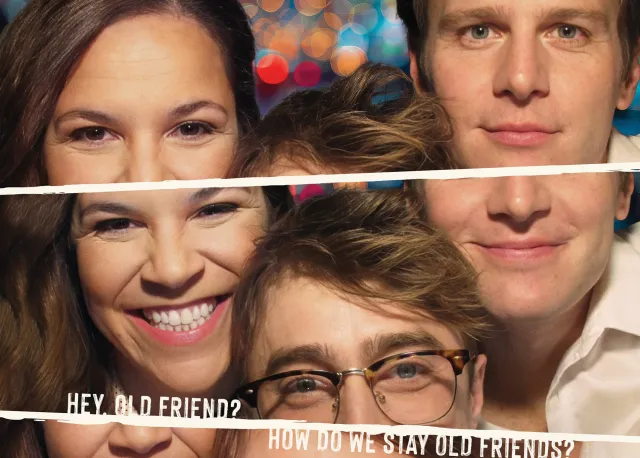
in Robin and the 7 Hoods
(© Craig Schwartz)
“Ring-a-Ding-Ding” is not only the 19th and final Sammy Cahn/Jimmy Van Heusen song heard in the new musical Robin and the 7 Hoods, now getting its world premiere at San Diego’s Old Globe Theatre, it also perfectly sums up the audience’s feeling for this delightful show. Playwright Rupert Holmes and choreographer/director Casey Nicholaw seem to have struck gold with this new musical, which is based oh-so-loosely on the 1964 film of the same name starring Frank Sinatra and the members of the so-called Rat Pack.
Holmes has wisely set the action in the now-popular Mad Men era of 1962. Robbo (Eric Schneider) is a likable gangster who is trying to go legit with a string of nightclubs; but he and his gang are forced to go back to their safecracking ways when crime boss P.J. Sullivan (Rick Holmes) tries to put them out of business by bribing cop Lieutenant Nottingham (Adam Heller). Crusading TV reporter Marian Archer (Kelly Sullivan) doesn’t help matters when she proclaims Robbo as a modern day Robin Hood, stealing from gangsters and giving to the poor.
Schneider possesses Sinatra’s suave and sophisticated coolness as Robbo, while putting his own stamp on the role. Among the gang members are Will Chase as Little John, Robbo’s number two, who gives a hint of the insouciant and lubricated nature of Dean Martin without ever lapsing into parody. Jeffrey Schecter as Willie Scarlatti retains Sammy Davis’ stellar tap dancing style. The major change here is now the character of Alana O’Dell is played by Amy Spanger — who obviously bears no resemblance at all to the film’s co-star, Bing Crosby.
The true joy of the show, though, is in hearing these pop songs used to advance plot and delineate character. “Call Me Irresponsible” is turned into a fun duet between the marriage-minded Alana and the footloose Little John. “I Like to Lead When I Dance” is a delightful male/female tussle for the top position in a budding romantic relationship between Robbo and Marian.
“Walkin’ Happy” turns into a tour-de-force tap number by Schecter as he merrily distributes stolen money to Chicago’s down-and-out citizenry; “Come Fly With Me” becomes a whirlwind number by Little John and Alana; “All the Way” is Marian’s declaration of love; and perhaps the show’s funniest and most endearing number comes when Lt. Nottingham encourages Robbo to keep up the good fight with “High Hopes.”
Nicholaw’s direction is assured and deft, and his choreography is superb. Even though the chorus girls whipping their cat tails in “Life is for Livin'” is reminiscent of the cows in The Will Rogers Follies, and the hoods cavorting through “Come Blow Your Horn” resemble the gamblers in Guys and Dolls, these numbers are done with such élan and style that they come across as more homage than knockoff. And his Jailhouse Rock spin on “(Love Is) The Tender Trap” is truly show-stopping.
Robert Brill’s two-level open paneled scenic design perfectly fits all locales, while Kenneth Posner’s pinpoint lighting design and Gregg Barnes’ costumes are period perfect. And John McDaniel, Bill Elliott, Mark Hummel and David Chase have all contributed their considerable talents to making the songs sound sparkling fresh.







